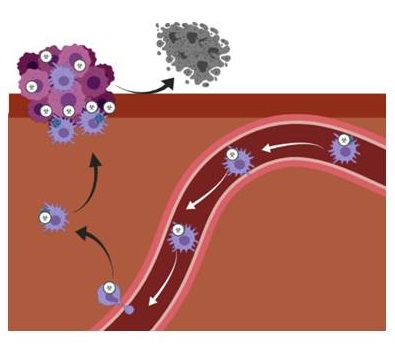Independent Cancer Biology Laboratory
Department of Cancer Biology has been formed in 2019 in the Institute of Biology
at Warsaw University of Life Sciences.
Our research interests are: tumor immunology, tumor microenvironment,
tumor hypoxia and drug delivery to solid tumors.

Team
eam

Prof. Magdalena Król – Head of Department, Group Leader
Education:
- 2019 – Full Professor nominated by the President of Poland
- 2014 – Habilitation (Post-doctoral degree) with distinction at the Warsaw University of Life Sciences
- 2009 – Doctoral degree (with distinction) at the Warsaw University of Life Sciences
Internships:
- 2018 – University of British Colombia, Canada – Visiting Researcher
- 2018 – Stanford University, CA, USA – Visiting Researcher
- 2017 – Sapienza University of Rome, Italy – Visiting Professor
- 2012 – Albert Einstein College of Medicine of Yeshiva University, NY, USA – Research Associate
- 2009 – Netherlands Cancer Institute, Amsterdam, The Netherlands – Research Fellow
- 2007 – Swedish University of Agricultural Sciences, Sweden – Visiting Scientist
- 2007 – Utrecht University, The Netherlands – Visiting Scientist
Scientists
Dr. Bartłomiej Taciak, PhD – Assistant Professor
Dr. Taciak has obtained PhD degree in 2019 at Warsaw University of Life Sciences. During his scientific career he has completed many internships at: Nencki Institute, Groningen University (The Netherlands), Edinburgh University (UK), Bilkent University (Turkey), La Sapienza University of Rome (Italy).
Dr. Paulina Kucharzewska–Siembieda, PhD – Assistant Professor
Dr. Kucharzewska-Siembieda has obtained her PhD degree in experimental oncology in 2014 at Lund University in Sweden. Later (2014-2017) she obtained a Postdoc position in AstraZeneca (Goeteborg, Sweden) in iMED RIA (Respiratory, Inflammation and Autoimmunity Diseases) biotech unit. She has joined our group in 2017.
Dr. Krzysztof Lacek, PhD – Research Associate (Cellis Ltd.)
Dr. Lacek has obtained his PhD degree in 2015 at the University of Gdansk and the Medical University of Gdansk (Poland). During his PhD studies he has completed two internships at Tubingen University (Germany). For two years he worked in Italy for Okairos Srl (acquired by GlaxoSmithKline) and PeptiPharma. He has joined our team in 2019.
Maciej Białasek, MSc – PhD candidate
Małgorzata Kubiak, MSc – PhD candidate
Małgorzata Górczak, MSc – PhD candidate
Łukasz Kiraga, DVM – PhD student
Irena Pruszyńska, DVM – PhD student
Emilia Górka, MSc – Lab Manager
Anna Smolarska, MSc – technician
Administration
Dr. Anna Sikora-Koperska, PhD – Project Manager (co-works for Cellis Ltd.)
Karolina Witczak, MSc – Administration Specialist
Małgorzata Sęktas, MSc – Office Manager (Cellis Ltd.)

sdr
Research Interest
Research Interest

According to the US Cancer Statistics Incidence and Mortality Web-based Report in 2014, in the US alone someone died of cancer every minute. According to Cancer Research UK one in two of us will be diagnosed with cancer during our lifetimes. One out of four of these people will die because of this disease.
Even if annual cancer mortality has slightly decreased, this is mainly related to an improvement in early diagnosis. Results of therapy are still unsatisfactory. Firstly, only up to 2% of the administered drug reaches the solid tumor, while the rest goes to other tissues causing side effects. That poor drug distribution in tumor tissue is related to characteristics of its microenvironments that limit drug penetration, thereby exposing the tumor to lower than efficacious concentrations of drugs.
Therefore, our main research interest is in development of novel approaches to treat solid tumors: improved drug delivery (targeted delivery), delivery to hypoxic and unreachable sites of the tumor, develop novel combinations of immunotherapies or harness the immune system for the elimination of cancer.
Recently, we focused on investigation of TRAIN (TRAnsfer of Iron-binding proteiN) mechanism, that has been discovered by our team together with Dr. Tomasz Rygiel from Cellis Ltd. and Medical University of Warsaw and Prof. Alberto Boffi from Sapienza University of Rome (Italy). This discovery is very important for the scientific society working on homeostasis and immune-oncology, as well as interactions within tumor microenvironment.

On the other hand, TRAIN discovery gives possibility to “smuggle” anticancer drugs to the tumor. This method allows us to create a “Trojan horse” that we may use to deliver drugs directly to the tumor site.

This discovery may be exploited in practice (three International patent applications PCT and one national application have been deposited so far). Therefore it gives us the real possibility to work in order to translate our research discovery into the real therapy and to improve human life.

Currently we are conducting two scientific projects: ERC Starting Grant and Polish-Turkish grant from the National Centre for Research and Development and one commercial project together with a start-up company Cellis Ltd.
Recent Scientifc Achievements
TRAIN (TRAnsfer of Iron-binding proteiN) discovery
We have discovered completely new mechanisms of iron-binding proteins (e.g. ferritin) uptake from microenvironment by immune cells, especially macrophages, followed by their transport to cancer cells – TRAIN (TRAnsfer of Iron-binding proteiN). So far this mechanisms was unknown. Thus, its aim and physiological basis need further investigation. It is studied within the ERC Starting Grant entitled “Entrapment of Hypoxic Cancer by Macrophages Loaded with HAP”. In 2018 the project has been awarded by the European Research Council as one of 10 the most important projects in the past 10 years. This discovery is very important for the scientific society working on iron metabolism and homeostasis and for those working on immune-oncology and interactions occurring within tumor microenvironment.
TRAIN discovery shows that an unknown way of communication between macrophages and cancer cells exist. However, it gives possibility to “smuggle” anticancer drugs directly to cancer cell. Considering ability of drug encapsulation inside ferritin cavity, macrophage physiological abilities to migrate to the tumor mass, especially its avascular regions, and further transfer (TRAIN) inside tumor mass, this method allows us to create a “Trojan horse” that we may use to deliver drug directly to the tumor site. This discovery may be exploited in practice.These main findings will be published soon (patent applications has been filed).
So far some additional papers related to this technology have been published:
- Kiraga L , Cerutti G, Braniewska A, Strzemecki D, Sas Z, Boffi A, Savino E, Montemiglio LC, Turnham D, Seaton G, Bonamore A, Clarkson R, Dabkowski A, Paisey S, Rygiel T, Krol M. Pharmacokinetics of human hemoglobin-DFO 89Zr complex in mice determined by PET, Nature Scientific Reports (in revision)
- Calisti L, Trabuco MC, Boffi A., Testi C, Montemiglio L.C, des Georges A, Benni I, Ilari A, Taciak B, Białasek M, Rygiel T, Król M, Baiocco P, Bonamore A (2018) Engineered ferritin for lanthanide binding. PLoS ONE 13(8): e0201859
- Taciak B, Białasek M, Braniewska A, Sas Z, Sawicka P, Kiraga Ł, Rygiel T, Król M (2018) Evaluation of phenotypic and functional stability of RAW 264.7 cell line through serial passages. PLoS ONE 13(6): e0198943
- Kiraga Ł, Cheda Ł, Taciak B, Różańska K, Tonecka K, Szulc A, Kilian K, Górka E, Rogulski Z, Rygiel TP, Król M. Changes in hypoxia level of CT26 tumors during various stages of development and comparing different methods of hypoxia determination. PLoS One. 2018 Nov 9;13(11):e0206706
MicroRNAs may act as oncogenes or tumour suppressor genes, which make these small molecules potential diagnostic/prognostic factors and targets for anticancer therapies
The expression profiles of 317 microRNAs in 146 canine mammary tumours of different histological type, grade and clinical history (presence/absence of metastases) and in 25 control group samples were identified. The results show that the most significant difference in microRNA expression is between the metastatic and the non-metastatic group, which indicates a more important role of microRNAs in the metastasis process than in the malignant transformation. Moreover, the differentially expressed microRNAs constitute metastasis markers which could be used in cancer diagnosis in the future for example in tumor biopsies or in tissue sections remover during the mastectomy. Unfortunately, exploiting of microRNA as a blood-borne diagnostic tool for cancer failed. We have investigated presence of a number of the most important microRNAs identified in the tissues and in the blood of tumor-bearing dogs. Our study showed that their levels did not correlate with presence of the mammary cancer.

These results have been published in:
Bulkowska M, Rybicka A, Senses KM, Ulewicz K, Witt K, Szymańska J, Taciak B, Klopfleisch R, Hellmen E, Dolka I, Gure AO, Mucha J, Mikow M, Giziński S, Król M (2017) MicroRNA expression patterns in canine mammary cancer show significant differences between metastatic and non-metastatic tumours. BMC Cancer 17:728, DOI 10.1186/s12885-017-3751-1Identification of interactions between canine mammary cancer cells and tumor
microenvironmentThe research allowed understanding of complex interactions between cancer cells, and macrophages, tumor-associated fibroblasts and other cells. We showed that tumor-associated macrophages directly or indirectly change location of Wnt receptors on the cancer cell surface, changing cancer cell shape by F-actin reorganization. However, this does not occur only due to their direct contact. Macrophages secrete in a constitutive manner non-canonical Wnt activators (and at the same time canonical-Wnt inhibitors) in exosomes in order to increase cell migration in a wound healing process. An important finding is that the use of the Wnt pathway inhibitors for cancer treatment or as a supplementary drugs may lead to serious ‘side effects’. The anticancer drugs e.g. natural products that are often used as diet supplements (e.g. quercetin that is a blocker of one of the Wnt traits) may somehow stop tumor grow and proliferation of cancer cells, however they increase their ability to migrate and to form metastases. However, this effect may be inhibited by the use of synthetic analogues of migrastatins. Migrastatin is a natural compound from Streptomyces platensis that influences F-actin and inhibits cytoskeleton rearrangement. This cytoskeleton rearrangement is caused by the Wnt trait identified by our group, as the one being activated by macrophages.
We have received many awards for all these achievements, as well as our articles have been selected as cover articles or highlighted by the editor as „VIP – very important paper”.
Published papers:
- Lo Re D, Zhou Y, Mucha J, Jones LF, Leahy L, Santocanale C, Krol M, Murphy PV (2015) Synthesis of migrastatin analogues as inhibitors of tumour cell migration: exploring structural change in and on the macrocyclic ring, Chemistry – A European Journal, doi. 10.1002/chem.201504167 Cover Article
- Gabba A, Robakiewicz S, Taciak B, Ulewicz K, Broggini G, Rastelli G, Król M, Murphy PV, Passarella D (2016) Synthesis and biological evaluation of migrastatin macrotriazoles. European Journal of Organic Chemistry 60-69, DOI. 10.1002/ejoc.201600988
- Pingwara R, Witt-Jurkowska K, Ulewicz K, Mucha J, Tonecka K, Pilch Z, Taciak B, Zabielska-Koczywąs K, Mori M, Berardozzi S, Botta B, Rygiel T, Król M (2017) Interferon-λ promotes mammary tumor metastasis via angiogenesis extension and stimulation of cancer cell migration. Journal of Physiology and Pharmacology 68(4): 573-583
- Zabielska-Koczywąs K, Dolka I, Król M, Żbikowski A, Lewandowski W, Mieczkowski J, Wójcik M, Lechowski R (2017) Doxorubicin conjugated to glutathione stabilized gold nanoparticles (Au-GSH-Dox) as an effective therapeutic agent for feline injection-site sarcomas – chick embryo chorioallantoic membrane study. Molecules 22: 253, DOI. 10.3390/molecules22020253
- Rybicka A, Eyileten C, Taciak B, Mucha J, Majchrzak K, Hellmen E, Król M (2016) Tumour-associated macrophages influence canine mammary cancer stem-like cells enhancing their pro-angiogenic properties, Journal of Physiology and Pharmacology, 67 (5): 491-500
- Mucha J, Homa A, Dolka I, Szymańska J, Manuali E, Parzeniecka-Jaworska M, Kluciński W, Król M (2016) Immunosuppression in dogs during mammary cancer development, Veterinary Pathology, DOI. 10.1177/0300985816634808
- Khan MI, Czarnecka A, Lewicki S, Helbrecht I, Brodaczewska K, Koch I, Zdanowski R, Król M, Szczylik C (2016) Comparative gene expression profiling of primary and metastatic renal cell carcinoma stem cell-like cancer cells, PLoS ONE, 11(11): e0165718, DOI. 10.1371/journal.pone/0165718
- Dolka I, Król M, Sapierzyński R (2016) Evaluation of apoptosis – associated proteins (Bcl-2, Bax, cleaved caspase 3 and p53) expression in canine mammary tumors: an immunohistochemical and prognostic study, Research of Veterinary Sciences 105: 124-33
- Wojcik M, Lewandowski W, Krol M, Pawlowski K, Mieczkowski K, Lechowski R, Zabielska K (2015): Enhancing anti-tumor efficacy of doxorubicin by non-covalent conjugation to gold nanoparticles – in vitro studies on feline fibrosarcoma cell lines, PLoS ONE 10(4): e0124955.
- Rybicka A, Mucha J, Majchrzak K, Taciak B, Hellmen E, Motyl T, Król M (2015) Analysis of miRNA expression in canine mammary cancer stem-like cells shows epigenetic regulation of TGF-Beta signalling, Journal of Physiology and Pharmacology, 66 (1): 29-37
- Mucha J, Majchrzak K, Taciak B, Hellmen E, Król M (2015) MDSCs Mediate Angiogenesis and Predispose Canine Mammary Tumor Cells for Metastasis via IL-28/IL-28RA (IFN-λ) Signaling, PLoS ONE 10.1371/journal.pone.0103249 .
- Winiarska M, Bojarczuk K, Pyrzyńska B, Bil J, Siernicka M, Dwojak M, Bobrowicz M, Miazek N, Zapała P, Zgożdżon A, Król M, Syta A, Podszywałow-Bartnicka P, Dąbrowska-Iwanicka A, Juszczyński P, Efemov D, Słabicki M, Zenz T, Le Roy A, Oliver D, Gołąb J (2014) Inhibitors of SRC kinases impair antitumor activity of anti-CD20 mAbs. mAbs 6:5, 1-13
- Juchno D, Jabłonka O, Boroń A, Kujawa R, Leska A, Grabowska A, Nynca A, Świgońka S, Król M, Spóz A, Laskowska A, Lao M (2014) Ploidy-dependent survival of progeny arising from crosses between natural allo-triploid Cobitis females and diploid C. taenia males (Pisces Cobitidae), Genetica, DOI. 10.1007/s10709-014-9779-0
- Rybicka A, Król M (2016) Identification and characterization of cancer stem cells in canine mammary tumors. Acta Veterinaria Scandinavica 58:86. DOI. 10.1186/s13028-016-0268-6
- Yuan LQ, de Jesus Perez V, Liao XB, Król M, Yeh CH (2017) MicroRNA and cardiovascular disease 2016. BioMed Research International 3780513. DOI. 10.1155/2017/3780513
- Mucha J, Motyl T, Król M (2016) Influence of lymphocytes T and myeloid-derived suppressor cells on inhibition of antitumor response. Medycyna Weterynaryjna 72(12): 735-739.
- Eyileten C, Majchrzak K, Pilch Z, Tonecka K, Mucha J, Taciak B, Ulewicz K, Witt K, Boffi A, Król M, Rygiel T (2016) Immune cells in cancer therapy and drug discovery, Mediators of Inflammation, doi.org/10.1155/2016/5230219
- Khan MI, Sobocińska AA, Czarnecka AM, Król M, Botta B, Szczylik C (2015) The therapeutic aspects of the endocannabinoid system (ECS) for cancer and their development: from nature to laboratory, Curr Pharm Des. 22: 1756-1766
- Liao XB, Jesus Perez VA, Krol M, Yeh CH, Yuan LQ (2015) Micro RNA and cardiovascular disease, BioMed Research International, ID: 734380 Editorial Article
- Król M, Motyl T (2015) Exploiting cancer genomics in pet animals to gain advantage for personalized medicine decisions, Journal of Applied Genetics 55: 337-341 Invited Article
- Król M, Pawłowski KM, Majchrzak K, Mucha J, Motyl T (2014) Canine mammary carcinoma cell lines are resistant for chemosensitizers: Verapamil and Cyclosporin A. Polish Journal of Veterinary Sciences 17 (1), 9-17
- Król M, Majchrzak K, Mucha J, Homa A, Bulkowska M, Jakubowska A, Karwicka M, Pawłowski K, Motyl T (2013) CSF-1R as an inhibitor of apoptosis and promoter of proliferation, migration and invasion of canine mammary cancer cells, BMC Veterinary Research 9:65 Highly Accessed
- Dolka I, Sapierzyński R, Król M (2013) Retrospective study and immunohistochemical analysis of canine mammary sarcomas, BMC Veterinary Research, 9: 248
- Majchrzak K, Lo Re D, Gajewska M, Bulkowska M, Homa A, Pawłowski KM, Motyl T, Murphy PV, Król M (2013) Migrastatin analogues inhibit canine mammary cancer cell migration and invasion, PLoS ONE 8(10):e76789
- Pawłowski KM, Mucha J, Majchrzak K, Motyl T, Król M (2013) Expression and role of PGP, BCRP, MRP1 and MRP3 in multidrug resistance of canine mammary cancer cells, BMC Veterinary Research 9:119 Highly Accessed
- Pawłowski KM, Maciejewski H, Dolka I, Mol JA, Motyl T, Król M (2013) Gene expression profiles in canine mammary carcinoma of various grades of malignancy. BMC Veterinary Research 9:78
- Pawłowski KM, Homa A, Bulkowska M, Majchrzak K, Motyl T, Król M (2013) Expression of inflammation-mediatted cluster of genes as a new marker of canine mammary malignancy. Veterinary Research Communications 37:123-131
- Majchrzak K, Pawłowski KM, Orzechowska EJ, Dolka I, Mucha J, Motyl T, Król M (2012) A role of ghrelin in canine mammary cancer cells proliferation, apoptosis and migration, BMC Veterinary Research, 8: 170 Highly Accessed
- Zabielska K, Lechowski R, Król M, Pawłowski KM, Motyl T, Dolka I, Żbikowski A (2012) Derivation of feline vaccine-associated fibrosarcoma cell line and it`s growth on chick embryo chorioallantoic membrane – a new model of veterinary oncological studies in vivo; Veterinary Research Communications, 36(4):227-33
- Manuali E, Giuseppe De A, Feliziani F, Forti K, Casciari C, Marchesi MC, Pacifico E, Pawłowski KM, Majchrzak K, Król M (2012) CA15-3 cell lines and tissue expression in canine mammary cancer and the correlation between serum levels and tumour histological grade, BMC Veterinary Research, 8:86 Highly Accessed
- Pawłowski KM, Popielarz D, Szyszko K, Gajewska M, Motyl T, Król M (2012) Growth Hormone Receptor RNA interference decreases proliferation and enhances apoptosis in canine mammary carcinoma cell line CMT-U27, Veterinary and Comparative Oncology, 10(1):2-15
- Król M, Pawłowski KM, Szyszko K, Maciejewski H, Manuali E, Dolka I, Jank M, Motyl T (2012) Gene expression profiles of canine mammary cancer cells grown with carcinoma-associated fibroblasts (CAFs) as a co-culture in vitro, BMC Veterinary Research, 8:35 Highly Accessed
- Król M, Pawłowski KM, Majchrzak K, Gajewska M, Majewska A, Motyl T (2012) Global gene expression profiles of canine macrophages and canine mammary cancer cells grown as a co-culture in vitro, BMC Veterinary Research, 8:16 Highly Accessed
- Majchrzak K, Szyszko K, Pawłowski KM, Motyl T, Król M (2012) A role of ghrelin in cancerogenesis, Polish Journal of Veterinary Sciences 15(1), 181-189
- Król M, Pawłowski KM, Dolka I, Musielak O, Majchrzak K, Mucha J, Motyl T (2011) Denisty of Gr-1 positive myeloid precursor cells, p-STAT3 expression and gene expression pattern in canine mammary cancer metastasis, Veterinary Research Communications, 35: 409-423
- Król M, Pawłowski KM, Majchrzak K, Dolka I, Abramowicz A, Szyszko K, Motyl T (2011) Density of tumor-associated macrophages (TAMs) and expression of their growth factor receptor MCSF-R and CD14 in canine mammary adenocarcinomas of various grade of malignancy and metastasis. Polish Journal of Veterinary Sciences 14: 3-10
- Pawłowski KM, Majewska A, Szyszko K, Motyl T, Król M (2011) Gene expression pattern in canine mammary osteosarcoma, Polish Journal of Veterinary Sciences, 14: 11-20
- Król M, Polańska J, Pawłowski KM, Turowski P, Skierski J, Majewska A, Ugorski M, Morty RE, Motyl T (2010) Molecular signature of cell lines isolated from canine mammary adenocarcinoma metastases to lungs, Journal of Applied Genetics 51(1): 37-50
- Król M, Pawłowski KM, Skierski J, Turowski P, Majewska A, Polańska J, Ugorski M, Morty RE, Motyl T (2010) Transcriptomic ”portraits” of canine mammary cancer cell lines with different phenotype, Journal of Applied Genetics 51(2): 169-183
- Król M, Pawłowski KM, Majchrzak K, Szyszko K, Motyl T (2010) Why chemotherapy can fail? Polish Journal of Veterinary Sciences, 13(2): 399-406
- Król M, Pawłowski KM, Skierski J, Rao NAS, Hellmen E, Mol JA, Motyl T (2009) Transcriptomic profile of two canine mammary cancer cell lines with different proliferative and antiapoptotic potential, Journal of Physiology and Pharmacology, 60:95-106
- Pawłowski KM, Król M, Majewska A, Badowska – Kozakiewicz A., Mol JA, Malicka E, Motyl T (2009) Comparison of cellular and tissue transcriptional profiles in canine mammary tumor, Journal of Physiology and Pharmacology, 60:85-94
- Rao NAS, van Wolferen ME, Gracanin A, Bhatti SFM, Król M, Holstege FC, Mol JA (2009) Gene expression profiles of progestin-induced canine mammary hyperplasia and spontaneus mammary tumors, Journal of Physiology and Pharmacology, 60:73-84
Projects
Current scientific projects of our Team:

„Entrapment of hypoxic cancer by macrophages loaded with HAP”,
Starting Grant, European Research Council, 715048, McHAP, 2017-2021
”Identification of prognostic and drug-sensitivity biomarkers
in triple-negative breast cancer and results validation in vitro and in vivo”,
Polish-Turkish, POLTUR2/PC-TNBC/30/2016, PC-TNBC, 2018-2021
Premia on Horizon: ”Entrapment of hypoxic tumor by macrophages loaded with HAP”, MNiSW, 355135/PnH/2017, 2017-2021

„Development of cell-based drug delivery system to solid tumors”,
Project in cooperation with industry, 2016-2023Past projects of our Team:

- 2016-2019, ”Identification of molecular mechanisms of new, cell-based, targeted drug delivery system to solid tumors” , SONATA BIS, no. UMO-2015/18/E/NZ6/00642
- 2015-2018, Identification of the type of communications between tumor-associated macrophages and canine mammary cancer cells”, PRELUDIUM, no. UMO-2014/15/N/NZ5/03649
- 2014-2017, ”Inhibition of ”side effects” of tumor-associated macrophages in canine mammary cancer”, SONATA, no. UMO-2013/09/D/NZ5/02496
- 2012-2015, ”miRNA expression profiling of canine mammary cancer as a new tool in veterinary oncology”, OPUS, no. 2011/03/B/NZ5/05299

- 2015-2017, Iuventus Plus, MNiSW, IP2014 021073, ”Influence of tumor-associated macrophages on canine mammary cancer stem cells”
- 2012-2014, Iuventus Plus, MNiSW, IP2011027171, ”Identification of a role of myeloid-derived suppressor cells in cancer metastasis and immune-suppression in tumor-bearing dogs”
- 2010-2013, grant no: N N308012939 MNiSzW: ”Molecular interactions between macrophages and canine mammary cancer cells”
- 2011-2014, grant no: N N308574990 MNiSzW: ”Expression and susbtrates for the ATP-Binding Cassette, responsible for drug-resistance of canine mammary cancer”
- 2009-2012, grant no: N N308230536 MNiSzW: ”Transcriptomic profiles of canine mammary cancer cell lines of various proliferative and anti-apoptotic potential”
- 2006-2009, grant no: N30800632/0667 MNiSzW: “Transcriptomic profile of canine mammary tumors of various type and grade”
Labs
Laboratories of the Department of Cancer Biology:
Flow cytometry laboratory
Biochemistry laboratory
Tumor hypoxia laboratory
Cell culture laboratory
Laboratories of Warsaw University we use in collaboration:
Radioisotope/PET facility (in collaboration with Prof. Zbigniew Rogulski Group):
Mouse facility (in collaboration with Prof. Zbigniew Rogulski group):
Awards
Recent Awards of our Team
- Our project has been selected by the „My Company” magazine, as one of the top 25 innovations in Poland!
Link to the interview with Prof. Magdalena Król:
https://mycompanypolska.pl/artykul/3359/w-innowacji-trzeba-biecLink to the whole article:
https://mycompanypolska.pl/artykul/3361/top-lista-25-polskich-innowatorw?fbclid=IwAR1rGjluvRcrf5jXW9JVhncfK5TVZl0NcTZyQYNZHnOaBlmeWQeREHLEnzo
- European Research Council featured our McHAP project in celebratory book “Ten years, ten portraits”. This book has been issued to celebrate 10 years of the ERC.
Link to the multimedia product:
https://www.youtube.com/watch?v=gzu8jV3yzOc
- Our co-authored paper was selected by the Editor as VIP – very important paper!

- Our co-authored paper was on the cover of Chemistry – A European Journal

Other awards obtained by our Team:
- 2017 Man of the year in Science Category Awarded by the Gazeta Wyborcza daily
- 2015 The Highest Individual Scientific Award from the Rector of the Warsaw University of Life Sciences
- 2014 Science Ambassador in the ‘Profession: Scientist’ campaign organised by the Ministry of Science and Higher Education
- 2014 The highest Scientific Award in ‘Science’ category in ‘Poles with Verve’ plebiscite
- 2014 MENTORING fellowship from Foundation for Polish Science granted to the best scientists
- 2013 POLITYKA Weekly–The Highest Scientific Award in‘Science’ category (in competition of 170 Top Polish Scientists)
- 2013 L`Oreal&Unesco ‘for Woman in Science’ habilitation (postdoctoral degree) fellowship
- 2013 The Highest Group Award from the Rector of the Warsaw University of Life Sciences
- 2013 The Highest Group Award from the Polish Society of Veterinary Sciences
- 2013 Award from the Polish Society of Veterinary Sciences for the best monograph
- 2012 Fellowship from the Minister of Science & Higher Education for the Outstanding Young Researcher
- 2012 Young Investigator Scholarship in Veterinary Medicine Granted by Pfizer Animal Health
- 2012 START Fellowship for Outstanding Young Researchers from Foundation for Polish Science
- 2011 START Fellowship for Outstanding Young Researchers from Foundation for Polish Science
- 2011 Award of the Minister of Science and Higher Education for the papers about animal genomics
- 2010 The Highest Scientific Individual Award from the Rector of the Warsaw University of Life Sciences
- 2009 Mazovia Fellowship granted by the Marshal of Mazovia District

Students interested in working with us are more than welcome.
Please, send your CV and motivation letter via e-mail: spbn@sggw.edu.pl




























